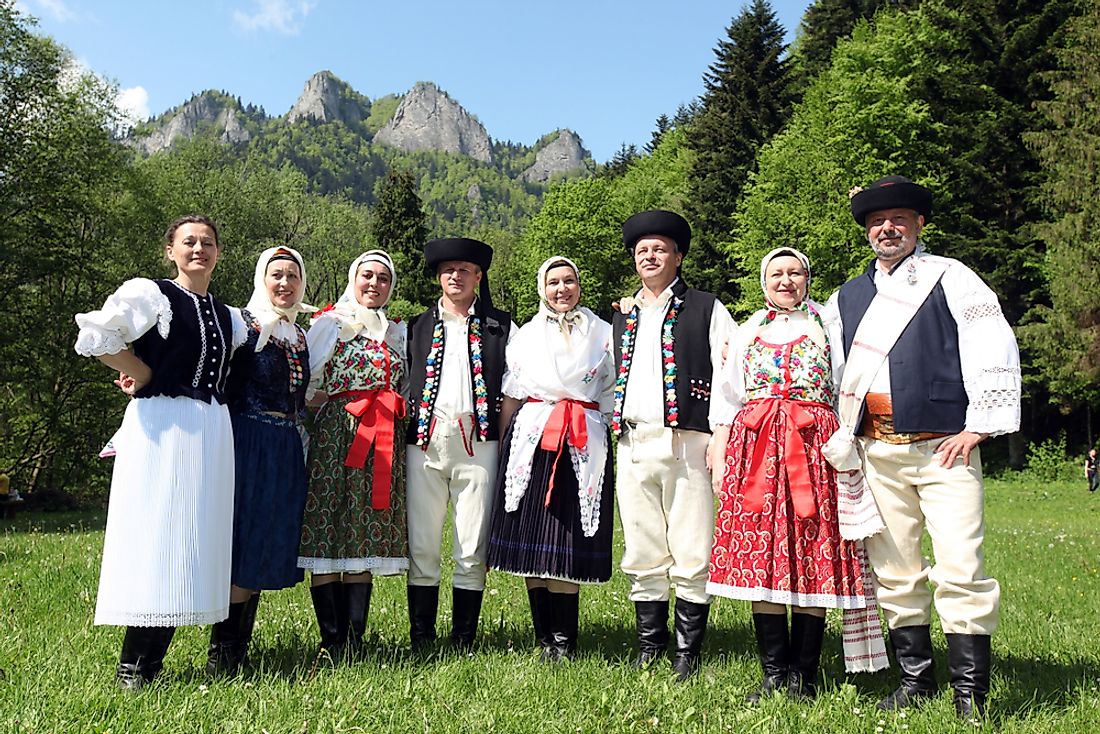The Culture Of Slovakia

Slovakia is a Central European landlocked country with a population of around 5,445,040 individuals. Ethnic Slovaks account for 80.7% of the country’s population. Hungarians, Romanis, Russians, Poles, Germans, etc., comprise the rest of the population. Christianity is the religion of the vast majority of Slovenia’s population. Roman Catholics represent 62% of the population.
5. Slovak Cuisine
The cuisine of Slovakia varies slightly from one part of the nation to another. It is influenced by the nation’s landscapes, climate, and the cuisines of neighboring countries. Wheat, dairy products, potatoes, pork, onion, and sauerkraut are important parts of the staple diet. Other common food items include mushrooms, fruits, eggs, beef, poultry, goat and lamb meat. Sausages, lard, and smoked bacon are typical pork products consumed by the Slovaks. Beer, fresh and sour milk are popular drinks. Some examples of traditional Slovak dishes are Bryndzové halušky (potato dumplings in sheep's-milk cheese), Zemiakové placky (fried potato pancakes), and Segedin goulash (a pork stew with sour cream and sauerkraut a served with steamed dumplings). Rice pudding, jam-filled steamed dumplings, sweet walnut and poppy seed rolls, laskonky, trdelník (traditional cake), etc., are some popular desserts of the cuisine.
4. Literature and the Arts
Prior to the development of formal written literature, Slovakia’s literature was based on the oral storytelling tradition. Folktales, fairy tales, heroic epics, historical stories, etc., were part of it. The earliest written literary works were related to Christianity. The Book of Oaths was the first printed book in the Slovak language. Over the years, the literary scene of the country was influenced by major national and global events. In the 19th and 20th centuries, poetry became an important medium of expressing the national spirit.
Slovakia has a thriving art and craft scene. Fine ceramics is produced in Modra. The Slovaks also excel in wood carving, glass making, sculpting, and painting. Modern art in the country reflects both Slovak folk themes and European themes. Today, the major cities of the country house many art galleries and museums that exhibit Slovak art and craft from the past and the present.
3. Performance Arts in Slovakia
The music of the country is influenced by both the folk music of the countrymen and that of neighboring nations. Folk music and dance performances are common during cultural festivals and ceremonies, especially in rural areas. Performers adorn folk costumes during such events. Although such performances are usually confined to small localities, the government is trying to promote Slovenia's folk heritage at the international level. Folk festivals like Východná are held for this purpose. Orchestras and chamber groups are found in many of Slovenia's major cities. Western pop and rock music are popular among youth in urban areas.
Theaters across Slovakia host numerous theatrical events including operas, plays, puppet shows, and skits. The country also has its own cinema industry, although it is relatively new.
2. Sport in Slovakia
The games played in Slovakia are influenced by its location and climate. In summer, the people of the country love to play football, tennis, and volleyball. They also enjoy outdoor activities like hiking, cycling, and swimming. In winter, snowboarding and skiing are popular activities. Slovakia has earnd great international repute in ice hockey and has one of the world's best teams in this game.
1. Life in a Slovak Society
In the traditional Slovak society, the gender roles were strictly defined. However, societal changes over the years have allowed women to enjoy equal rights and freedoms as men. Today, a large number of women in Slovakia work outside of their homes in a variety of fields ranging from education to business and administration. However, women, especially those in rural areas, are still expected to manage household chores even if they hold jobs outside the home.
In modern Slovakia, individuals of both sexes have the freedom to select their marriage partners. While traditional rural populations are more conservative about marriage, those in the urban areas are open to co-inhabitation prior to formal marriage. Divorces and remarriages have become more common in recent years. Same-sex unions are, however, frowned upon in society and not given legal recognition.
Children enjoy many privileges in society. They are highly valued with mothers given ample maternity leave to ensure the infants receive the needed care. Often, a cash bonus is given to parents when a child is born.
Although traditional households in Slovakia, especially in rural areas, are extended, nuclear families are now more common than before. In extended households, the residence is usually patrilocal where the married couple lives with the groom’s family. Men retain the highest authority in such households. Children, both male and female, inherit property equally.
Slovaks maintain a significant distance while speaking. Greetings are considered an important part of good etiquette. Shaking hands is common when meeting strangers while kissing on the cheeks is reserved for friends and relatives. Lunches are elaborate in nature. Visitors to a Slovak home are treated with food and drink.











